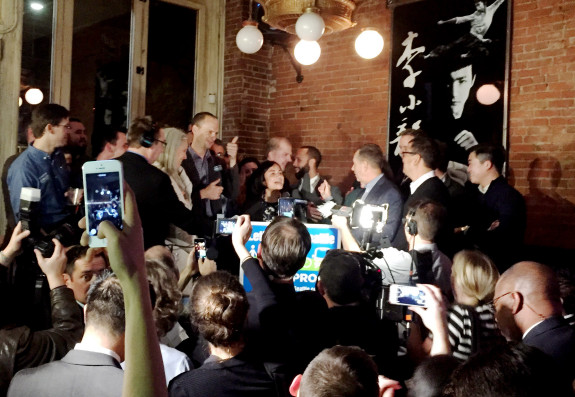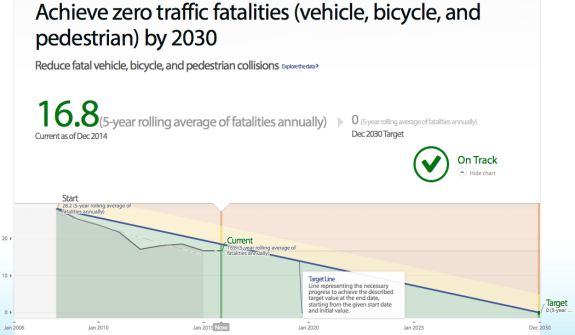 In an odd-year election, Seattle invested at least $400 million into safe streets, and every City Council candidate endorsed by Seattle Bike Blog, Seattle Transit Blog, Seattle Subway or Cascade Bicycle Club appears on the verge of winning.
In an odd-year election, Seattle invested at least $400 million into safe streets, and every City Council candidate endorsed by Seattle Bike Blog, Seattle Transit Blog, Seattle Subway or Cascade Bicycle Club appears on the verge of winning.
Urban cycling’s long existential crisis in Seattle is over. Bike lanes and safe streets are a core piece of our city and our politics. Putting walking, biking and transit first is mainstream policy now, and we have serious funding to back it up.
This is a landmark moment in a social movement to redefine streets as places focused on moving all people and goods rather than just being pipes for cars. Perhaps no other movement tracked so perfectly with the election results, as the Seattle Times noted.
For biking specifically, the cultural shift happened thanks to thousands of people all over our city (and many who have passed or moved away) working for years to make it happen: People biking on streets where nobody else dared go, people volunteering to teach bike repair in neighborhoods without bike shops, people organizing bike-to-school trains and inviting all their neighbors to join. No single organization, political leader or journalist can claim responsibility.
As of Wednesday evening’s count, the YES vote on the nine-year, $930 million Move Seattle levy has a 15-point lead. That’s for a bold measure that goes all-in on safe, vibrant and multimodal streets — a significant risk taken by city leaders in the Mayor’s Office, SDOT and the Council. It’s not just a ballot win, it’s a mandate.
Depending how you count it, at least $400 million will go specifically to safe streets projects (see the spending plan PDF). That number does not include the city’s general transportation budget or state and federal grants the city can now leverage. And much of the rest of the funding (for paving, signal timing, bridge repairs, freight corridors, transit efficiency, etc) will likely include safety elements, as well.
There is almost no money for new or wider roads, investments that often get huge percentages of transportation packages despite evidence that they don’t actually help relieve congestion (see also: Mercer Street). The levy plan acknowledges that Seattle’s only real option for moving more people and goods is to maintain the streets we have and invest heavily in more and faster transit, connected high quality bike routes and doing what we can to make walking easy and safe for everyone everywhere.
Seattle now has the responsibility to be a leader nationwide. Because as we have written before, our city is in the best position to reach Vision Zero among major cities in the US. The end is in sight (at least for fatalities), and we just funded the cure:
 None of this means the job is over. Making sure city leaders invest these new funds boldly is going to be hard and ongoing work. Many projects will still take a lot of political will. And, of course, there are all those communities outside the Seattle city limits.
None of this means the job is over. Making sure city leaders invest these new funds boldly is going to be hard and ongoing work. Many projects will still take a lot of political will. And, of course, there are all those communities outside the Seattle city limits.
But the job of bike advocacy has just broken wide open. Funding has been the one piece the movement has never fully achieved, so that has been the focus of advocacy work for years. So what now?
I asked longtime Seattle bike advocate and co-owner of G&O Family Cyclery Davey Oil this question, and he had this simple and spot-on answer: “We have to double down on building a just and equitable and safe society.”
Because now that biking is mainstream (many of the endorsed City Council candidates also received money from the Chamber of Commerce), the challenge is to stay on the forefront of what biking and safe streets can mean for everyone. Physical infrastructure is just one part of a city that values all people regardless of how they got there.
And that means building a wider coalition, giving space for more voices to take the mic and lead.
It means increasing the safe streets presence in neighborhood and business groups in all corners of the city.
It means working on bicycle access for everyone so bike improvements aren’t just for the already privileged.
It means demanding affordable housing near our quality bike routes as much as it means building bike routes in low-income neighborhoods.
And it means a lot of great ideas we haven’t even heard yet.
This is the biggest ever electoral victory for biking in Seattle. It’s hard to overstate what this means for our city’s future. The people of Seattle were at a pivotal moment: There was a strong push to second guess our transit, biking and walking vision for the city.
Instead, we’re all in. Now the really fun part begins: Making it real.








Comments
16 responses to “Seattle just elected a bike-friendly Council and invested $400M into safe streets”
I hope this means more people become involved with all the different organizations that push @SDOT in the right direction. It gets really disappointing to go to the different transit meetings and then, AGAIN, be the lady with the loud mouth and “ideas”. Does everyone want roads Shirley designs? You might not like my Star Wars bollards. People, if I make time to take my cranky children and myself to these meetings you can too. FYI Accessible Mt. Baker Open House is Nov 12th. http://www.seattle.gov/transportation/accessibleMtBaker.htm
“We are all in”
Remember to a politician that means, “all the people likely to vote for me, and the squeaky wheels.” Which generally translates to to people who know how to turn the wheels of justice and power, which means people of privilege. So if you truly want everybody in, we need to make sure that the voices of those who might not complain are represented at the table.
$400 million should just about cover the legal fees and endless studies on the Ballard Missing Link over the next 10 years. And in 10 years when the missing link still isn’t built we can make it a priority and ask for another $700 million in the next levy!
I would say that before another cent is spent on a study or another community meeting happens we need basic policy changes that reduce environmental impact study requirements for bike and ped infrastructure, standard design requirements for bike/ped facilities, and significant reductions in the Seattle Process and opportunities for frivolous legal challenges. Should businesses and residents in Seattle have the opportunity to question bike/ped investments? Of course. But if a compromise can’t be reached at one or two community meetings bring the issue to a expert review panel and give them a set amount of time to come to a resolution.
The missing link money drain can’t happen again and it already is on Westlake.
Land use law is largely controlled at the state level, not the city, thanks in large part to initiatives and legislative responses to them in the early 1990s. Seattle can’t change the requirement for SEPA/GMA reviews or the requirement for Environmental Impact Statements. And, while those processes get abused by NIMBYs all the time, I suspect voters would not appreciate having the Growth Management Act rolled back — while the system is cumbersome and has killed some good projects, it’s stopped a lot more bad ideas.
Another excellent post. Amazing progress ahead. I like the suggestion above about facilitating the process of approving protected bike lanes and walking infrastructure. I really want road diets and quality protected bike lanes on all major commute routes ASAP.
“Now the really fun part begins: Making it real.”
While I’m not quite done celebrating the ballot win, I agree with you 100%, the work continues, and I HOPE it’s fun. An advocate’s job is never done, really: Get the Money, Hold Feet to Fire, Repeat. Or, as I am fond of saying: “Eternal vigilance is the price of freedom — AND good built environment.”
Also, here is a “victory speech” by Mayor Murray on election night. He was cautiously optimistic.
Weird, the link didn’t show.
https://youtu.be/TSwrim7-ICI
[…] 2015: Voters were incredibly generous with the passage of a parks plan in Olympia, a major transportation measure in Seattle (and maybe so in Tacoma), a program to give disadvantaged youth a fair start ($) in […]
[…] Seattle’s election night victory assured a crucial chunk of funding for a new tram-like bus to run on E Madison, but the latest […]
[…] Sidewalk explains what Louisville can learn from Salt Lake City about improving its air quality. Seattle Bike Blog reports the local City Council recently approved a game-changing $400 million in spending for […]
[…] the changes follow what may be the organization’s best ever election victory. Not only did Cascade play a central role in the campaign to pass Move Seattle, an unprecedented […]
[…] I know HALA debates so far have been confusing and surprisingly heated. But coupled with passage of the Move Seattle levy, the HALA decisions have immense potential to open Seattle’s increasingly bikeable and […]
[…] Seattle, WA, is back on the bicycle track it would seem. In this odd-year election, Seattle preps itself to (hopefully) welcome a board of city council members who are all endorsed by multiple Seattle bicycle advocacy groups. More noteworthy though, is that the city has pledged an investment of $400 million USD to safer streets. […]
[…] summer 2016, and there are no plans for any of these corridors to be completed this year. The city passed Move Seattle, yet the bike plan is getting shorter, more fragmented and more delayed. Worse, city transportation […]
[…] The following day, Tom Fucoloro at Seattle Bike Blog was still feeling the buzz: […]